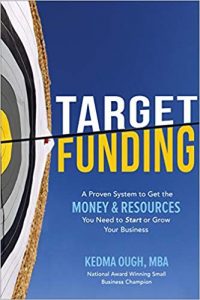Excerpted from “Target Funding: A Proven System to Get the Money and Resources You Need to Start or Grow Your Business“, p.15-19 (McGraw-Hill July 12, 2019).
The main reason the majority of startups and small businesses do not qualify for traditional debt and equity financing is because the risk is too high and the return on investment too low for those lenders and investors. Although most lenders and investors welcome the opportunity to finance small ventures that meet their criteria, the reality is that banks, venture capitalists, and other conventional financial institutions are risk adverse. Their priority is to mitigate their risk and make their shareholders happy. In the last 20 years, I have met very few loan officers who have ever ventured as an entrepreneur.


The Top 10 Barriers to Getting a Bank Loan
A lot of numbers go into the formula used by conventional lenders (banks, credit unions, finance companies, etc.) to determine whether to make a small business loan. The most important of those are the following.
Time in business. Two years is the minimum required by most banks. Banks rarely lend to startups with less than a year of solid revenues and without sufficient collateral. As a rule of thumb, the longer you’ve been in business and the stronger your financials, the more likely you are to secure a bank loan. That is because banks use historical data to predict future financial performance. If you are starting out and don’t have financial statements to show sales and expenses, it is difficult to make a reliable prediction.
Loan amount. Most large banks have a minimum business loan amount of $100,000 to $200,000 and sometimes higher. Although some banks offer business loans as low as $50,000, the average small business loan in the United States is about $600,000 for large banks and $150,000 for small banks. Three-quarters of small businesses (75 percent) seek loans of less than $250,000, more than half (55 percent) seek loans of less than $100,000, more than a third (34 percent) seek loans of $25,000 to $100,000, and almost a quarter (21 percent) seek loans of $25,000. Regardless of the loan amount, the bank will follow the same due diligence.
Business credit score. The FICO Small Business Scoring Service (SBSS), which is used for term loans and lines of credit up to $1 million, rates business credit on a scale of 0 to 300. The other three main business credit tracking agencies (Dun & Bradstreet, Equifax, Experian) use a scoring scale of 0 to 100. Most banks use the SBSS score because it’s based on your business credit score from the other three agencies combined with your personal FICO score and your business financials. Banks want an SBSS score of 160 or higher. Since many small business owners use their own funds to launch their businesses, the SBSS score of a business that’s been in operation only a few years may be low due to having little or no business debt.

Personal credit score. Your personal credit score also factors into the bank’s assessment of your business’s creditworthiness, on the grounds that how you’ve managed your personal debt is indicative of how you’ll manage your business debt. Your personal credit history will also reveal any personal loans you’ve used to fund your business, as many startups and small businesses do, which can result in a debt load that lowers your personal credit score. Most banks want to see a personal credit score of 700 or higher. A low personal credit score can result in being denied a business loan—even when the business is financially healthy.
Down payment. Banks typically require the business owner to plunk down at least 20 to 30 percent of the financed expense. The amount of the down payment depends on the type of loan and the collateral and/or assets used to secure the loan. Coming up with a down payment is difficult for many small business owners. In fact, almost two-thirds of small business owners cite lack of cash for a down payment as their top challenge in securing funding.
Collateral. Banks almost always require valuable assets owned by the borrower to secure business loans. Should the borrower default on the loan, the bank assumes ownership of the property. Banks want collateral that can be sold for cash, such as real estate and equipment, and the cash value of those assets usually needs to be equal to or greater than the loan amount. Many fledgling and small businesses do not own enough valuable assets to offer as collateral, and they may be unwilling or unable to use their personal assets (homes and cars) as collateral. In addition, the bank will determine the value of the collateral, and may assign a lower value on a particular asset than you would.
Debt ratio. One of the ways in which banks assess the financial stability and credit risk of a business is to measure the company’s total liabilities against its total assets. For example, if your business had $60,000 in liabilities and $100,000 in assets, your debt ratio ($50,000 divided by $100,000) would be 0.6. Banks typically require a debt ratio of 0.4 or lower.
Cash flow. Banks want to see at least $1.25 in positive cash flow for every $1 of total debt payment. This provides assurance that, every month, you’ll have enough money to pay the loan payment and all your business expenses and still have money left in the bank. Staying consistently, much less sufficiently, in the black is a challenge for most startups and many small businesses, even when they’re profitable. The median small business has $1.03 coming in for every $1 going out, on any given day. That is not much wiggle room for unplanned expenses, delayed payments from customers, and unexpected dips in sales. Inadequate cash flow to cover operating expenses is why 45 percent of business seek financing in the first place. It’s also one of the top reasons they’re denied bank loans.
Revenue. Banks typically require a minimum of $100,000 to $250,000 in annual revenue, depending on the type of loan, whether and how it is secured, the profitability of the business, and other factors. Some large banks set even higher revenue thresholds, and some banks and other conventional lenders accept revenues of less than $100,000 for otherwise financially sound small businesses. Only 35 percent of small businesses generate $100,000 or more in revenue, which knocks almost two-thirds (65 percent) of small businesses out of the running for the standard bank loan.
Profitability. Banks want to know that your business is profitable enough that you’ll have the liquid capital to pay back the loan. They’re usually interested in both your gross profit margins (earnings less cost of goods sold) and net profit margins (earnings less all expenses) over the last few years. They might also compare your profit margins with industry averages and your direct competitors. Almost 60 percent of small businesses are profitable, 18 percent are breaking even, and 24 percent are losing money. However, small business profit margins are often too narrow to meet the profitability thresholds set by most banks, and most new businesses don’t break even for two or three years.
The Atlanta Small Business Network, from start-up to success, we are your go-to resource for small business news, information, resources.


While you’re here, don’t forget to subscribe to our email newsletter for all the latest business news know-how from Atlanta Small Business Network.
This has been a JBF Business Media production.






